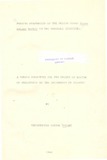| dc.description.abstract | This thesis consists of two parts, one establishing
the efficiency of plains zebra and a similar sized
ruminant in digesting various components of forage and
comprising the efficiencies of the two ungulates; the
second part concentrates on zebra and looks at how the
established digestive characteristics affect the species
use of phagic resources, and specifically how these
characteristics influence and constrain the feeding
strategies, behaviour and group dynamics of zebra.
"In Part I results indicated that zebra is as
efficient as the ruminant in the digestion of high
quality forage, but as the quality of forage drops the
ruminant is better off indigesting all forage components,
except protein. The capacity of zebra to digest protein
as well as the ruminant was apparent. Nitrogen recycling
has, however, been used to explain the superiority of the
ruminant to equines in protein assimilation. To date,
little work has been done on this aspect on equines,
and the litt1e done indicates that equines may have the
ability to recycle nitrogen. This calls for more
knowledge on the physiology of equines protein digestion.
However, keeping the lack of this information aside,
the larger intake of forage together with the rapid rate
of passage of ingesta through a zebra's digestive tract,
can allow the species to extract nutrients from forage
at an equivalent or higher rate than the ruminant, thus
compensating for the observed lower digestion
efficiencies.
In Part II the availability of forage (quantity
and quality) during different seasons and in different
habitats is presented. These resources were found to
be spatially and temporary variable. With this
information an attempt was made to establish how the
plains zebra adjust feeding strategies to cope with
the fluctuating resources by looking at activity
regimes, feeding behaviour, group size/composition and
the distribution and movement of the species.
The principal hypotheses used to investigate these
aspects were; that Zebra will maximise benefits through
maximising digestible intake per unit time and interindividual
distance, and that.animal movement will
follow the digestibility gradient in the habitat; that
non-optimal foraging patterns can be explained by
constraints such as predators, lack of utilizable
standing water, etc.; that the efficiency of energy
harvesting influences reproductive success by making
reproductive adjustments .to optimize energy harvesting;
and finally that zebra increase harvesting at the
expense of socialness.
Quantitative data on "how zebra distribute time
among various activities are presented. Grazing, moving
and standing are the main activities. Interseasonal
differences among age/sex categories in the proportions
of time allocated .t. o various activities have been drawn
out from the data and their adaptive significance
considered. On the whole foraging time was a major
factor governing the zebra 's _time budgets and zebra make
"decisions" about how much time to allocate to foraging,
so as to maximize or get the required intake of forage.
The adaptive responses in group dynamics to maintain
optimal utilization of resources were established with
data on seasonal changes in number of individuals in a
group together with changes in composition of the group.
Changes in group size were mainly due to the birth of
foals. Most births occurred during the wet season when
food resources were abundant
Data on spacing of individuals and rates of
progression while foraging together with temporal and
spatial distribution of zebra were collected with a
view to establishing how resources influence foraging
patterns. The data and their seasonal variability have
been presented. Zebra were found to progress faster
and space out more when forage availability was poor.
They also selected habitats with high quality and
quantity. Zebra also preferred areas with grass
greenness of over 50% especially during the dry season.
These observations have finally been discussed as
processes for optimizing food intake. The factors which
inhibit optimization were found to be availability of
surface water and predator avoidance. The order of
habitat preferences was found to correspond with the
severity of these two factors.
The results of this' study were found to be
consistent with expectations based on the food selection
model of optimization and support the validity of
extending the model to habitat selection. | |

